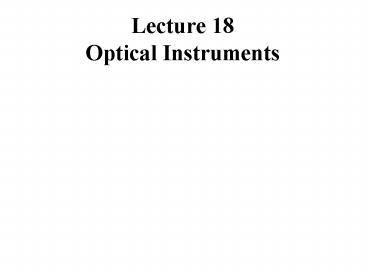Lecture 18 Optical Instruments - PowerPoint PPT Presentation
Title:
Lecture 18 Optical Instruments
Description:
Lecture 18 Optical Instruments Chapter 25 Outline The Camera and the Eye The Microscope and the Telescope Results from geometric optics The Camera Diopter Concept of ... – PowerPoint PPT presentation
Number of Views:89
Avg rating:3.0/5.0
Title: Lecture 18 Optical Instruments
1
Lecture 18Optical Instruments
Chapter 25
Outline
- The Camera and the Eye
- The Microscope and the Telescope
2
Results from geometric optics
Thin-lens equation
Lateral Magnification
1 1 1 ? ? ? p q f
? q M ?? p
For a system of two lenses, the image formed by
the first one is treated as the object for the
second one. The image formed by the second lens
is the final image of the system. The overall
magnification is the product of the
magnifications of the individual lenses.
3
The Camera
The camera is a simple optical system to produce
an image on film (we consider single-lens camera).
Additional information about the light intensity
(I) is needed. I is the rate at which energy is
received by film per unit area of the image (A).
I D2, where D is the lens diameter A q2, q ?
f ? A f2
I D2/f2
New parameter, f-number ? f/D ? lens speed
4
Diopter
The power P of a lens in diopters equals the
inverse of the focal length in meters P 1/f
A converging lens of f 1 m has P 1
diopter. A diverging lens of f ?1 m has P
? 1 diopter.
If the far point of the eye is 25 cm
(nearsightedness), a lens with f ? 25 cm would
correct the problem.
The power of this lens is
? 4 diopters (not ? 0.4!)
5
Concept of Resolution
Linear resolution is the minimum distance between
any two objects to be viewed separately. Angular
resolution is the minimum angle between any two
objects to be viewed separately.
6
Summary
- Simple treatment of light as rays in the
geometric optics approximation allows to design
powerful optical systems (cameras, correction
lenses, microscopes, and telescopes) - Angular magnification describes an apparent
increase of an object in size when a lens or a
combination of lenses is used compared to the
naked eye.





















![Lecture note : Gas chromatography [2] ????????? ??? PowerPoint PPT Presentation](https://s3.amazonaws.com/images.powershow.com/6741367.th0.jpg?_=20150612015)









